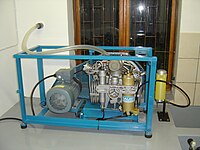
Photo from wikipedia
Abstract This study’s objective was to evaluate the influence of thermal environment and air velocity during the rearing phase on European quail meat quality traits. A total of 1,152 one-day-old… Click to show full abstract
Abstract This study’s objective was to evaluate the influence of thermal environment and air velocity during the rearing phase on European quail meat quality traits. A total of 1,152 one-day-old European quail chicks were placed inside floor pens within environmental chambers. Each experimental period was approximately 5 wks, with birds slaughtered at 37 d of age. The experimental design consisted of a 2 × 4 factorial arrangement of treatments in completely randomized design with 2 air velocities (0 and 2 m/s) × 4 air temperatures (severe cold [SC], moderate cold, thermal comfort, and moderate heat [MH]). ANOVA, with air velocity and thermal environment as fixed effects, was performed to evaluate the effect of main factors and their interaction on meat quality traits, using the GLM procedure (SAS 9.4). Least square means of treatments effects were compared using Tukey’s test (α = 0.05). Lightness (L∗), redness (a∗), and yellowness (b∗), of quail meat were affected by thermal environment and air velocity (P 0.05). Interactions were not significant for pHu (P = 0.993). Thawing loss and shear force were affected by treatments (P
Journal Title: Poultry Science
Year Published: 2020
Link to full text (if available)
Share on Social Media: Sign Up to like & get
recommendations!